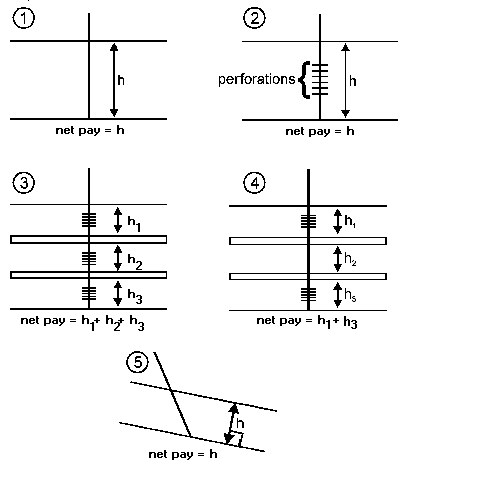Formation Properties
Subtopics:
Formation Compressibility (cf)
Formation compressibility is the change in rock volume per unit volume per unit change in pressure. The formation, even though it is a solid material, is compressible. The formation compressibility is used in the calculation of total compressibility (ct).
It is of the same order of magnitude as the oil compressibility (co) or the water compressibility (cw), approximately 10-6 1 / psi.
Thus, in the absence of gas saturation (Sg), the formation compressibility is relatively significant and must not be ignored.
However, when there is gas present in the pores, the gas compressibility (cg) is one or two orders of magnitude higher, and the formation compressibility is relatively small and may be ignored.
The formation compressibility may be measured in the laboratory, but it is usually derived from correlations. It is obvious that the nature of the formation, its degree of consolidation, its stress field, etc. all affect the formation compressibility, yet the correlations that exist do not take all of these factors into account. They are very simplified and relate the formation compressibility to the total porosity (f). The correlation used in this software is applicable to sandstones and carbonates. It was derived, from laboratory measurements, by Hall and published in the Transactions, AIME (1953) 198, p. 309.
Gas Saturation (Sg)
The gas saturation is the fraction of the pore space occupied by gas. Most gas reservoirs also contain some connate (non-movable) water (see water saturation (Sw)).
If the gas reservoir is part of a gas cap in a saturated oil reservoir, the space may contain gas, oil, and water. Thus the gas saturation is rarely 100% but varies from 30% to 90%. Gas saturation is used directly in the calculation of the reserves and also in the calculation of total compressibility (ct). Note that the gas saturation has a significant effect on the total compressibility (ct) since the gas compressibility is much higher than the other fluid compressibilities (oil (co) and water (cw)).
Net Pay (h)
This is the thickness of the formation that contributes to the flow of fluids. It is determined from core or log analysis, and can be different from the gross pay, or the perforated interval (hp). In the case of an inclined or deviated wellbore in a declining formation, the net pay is measured perpendicular to the angle of decline. Several examples of net pay are shown below.

Oil Saturation (So)
Oil saturation is the fraction of the pore space occupied by oil. Most oil reservoirs also contain some connate water (non-movable) (see water saturation (Sw)). Thus, the oil saturation is rarely 100% and usually ranges from 10% to 90% (in the oil / water transition zones). The oil saturation directly affects the calculation of reserves and total compressibility (ct).
Total Compressibility (ct)
The compressibility of a substance is the change in volume per unit volume per unit change in pressure. In a reservoir that consists of rock and pore space occupied by oil, water, and gas, the total compressibility is defined as follows:
From this definition, the total compressibility takes into account the compressibility and saturation of gas (Sg), oil (So), and water (Sw) as well as the (rock) formation compressibility (cf).
Note that the gas saturation (Sg) has a significant effect on the total compressibility (ct) since the gas compressibility (cg) is much higher than the other fluid compressibilities (oil (co) and water (cw)).
Thus, if there is any gas present in the reservoir, the total compressibility is dominated by the gas compressibility (cg) component.
The total compressibility has only a small effect during pressure transient flow analysis (it occurs within the log term in the skin calculation equation for radial flow), but it has a significant effect during pseudo-steady state (PSS) flow as it directly affects the total energy content of the reservoir.
In pressure transient analysis, the total compressibility is assumed constant, except for the case of gas pseudo-time in which the total compressibility is allowed to vary with pressure. Note that when forecasting production rates in a gas reservoir, if the forecast duration is much longer than the time to pseudo-steady state, significant errors in the late-time forecast may result (the rate will be under-predicted) when assuming a constant total compressibility.
Total Porosity (f)
The total porosity is the percentage volume occupied by the pore space, regardless of the type of fluids contained in the pore space. It is obtained from core or log analysis.
When using this parameter for pressure transient analysis, it is assumed that the pore space is filled with a single-phase fluid (either gas, oil, or water), such that the total porosity equals the porosity of that specific fluid. In reality, this is rarely the case, and the total porosity is usually filled with a mixture of gas, oil, and water.
Total porosity is used to calculate formation compressibility (cf) and thus affects the total compressibility (ct). The total porosity has only a small effect during pressure transient flow analysis (it occurs within the log term in the skin calculation equation for radial flow), but it has a significant effect during PSS flow as it directly affects the reserves contained in the reservoir.
Water Saturation (Sw)
The water saturation is the fraction of the pore space occupied by water. Most reservoirs are water wet and contain connate water.
Water saturation may range from 10% to 50% for an oil or gas reservoir, and it will be 100% for an aquifer. The water saturation obviously affects the oil and gas reserves, and is also used in the calculation of total compressibility (ct).